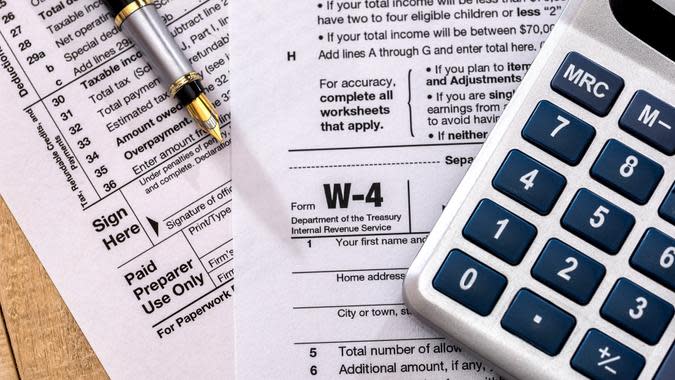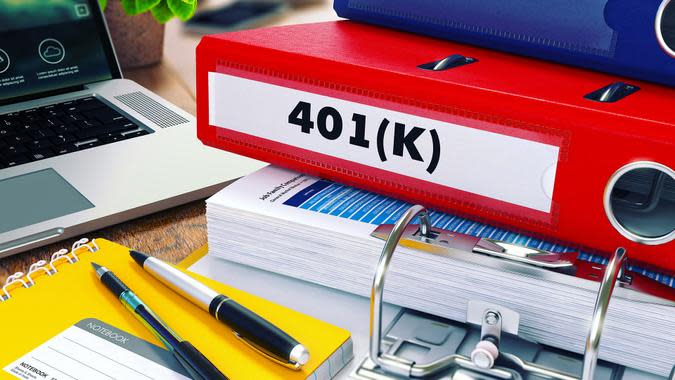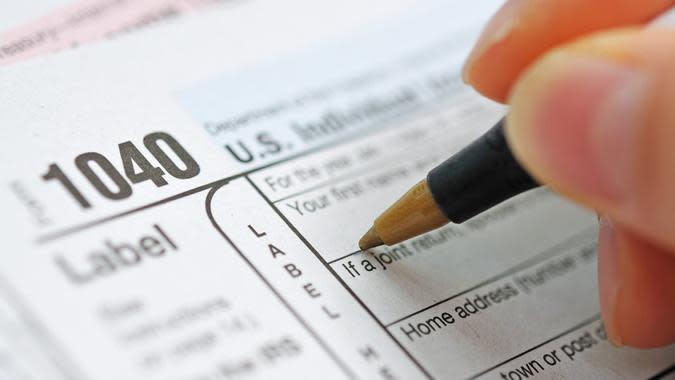Tax Mistakes Everyone Makes and How To Avoid Them

When it comes to Tax Day fears, many Americans are afraid they will make an error on their tax forms. A recent GOBankingRates survey found that nearly a quarter of Americans (22%) worry about making a mistake.
Read: This Is the One Type of Debt That ‘Terrifies’ Dave Ramsey
Find Out: Owe Money to the IRS? Most People Don’t Realize They Should Do This One Thing
Taking steps to be better prepared for Tax Day is the best way to avoid a potential error. When you file your taxes, there are a few easy-to-make mistakes you’ll need to dodge. Failing to do so could put your finances in jeopardy for the rest of the year.

Forgetting To Review Payroll Withholding Deductions
Getting a tax refund feels good. But if you are a salaried employee or hourly wage earner, it pays to understand why that money is coming back to you.
Over the course of the year, your employer deducts taxes from each of your paychecks and sends that money to the IRS on your behalf. If you get a refund, it means you overpaid. In other words, your estimation of how much you owed was too high.
Employers base payroll deductions on the information you provide when you complete your W-4 form, which lists your dependents and other tax-related information. Trish Maselli, founder and CEO of Clear Cut Accounting Services in Ivoryton, Connecticut, said employees who don’t fill out their W-4 forms correctly might end up overpaying on federal and state taxes throughout the year.
Instead, learn how to fill out a W-4 correctly.
If you overestimate, you’ll get a refund. But this means you have effectively used the IRS as a zero-interest savings account for the past 12 months. “My rule of thumb is to have at least 10% of your income taken out of your income,” Maselli said.
On the other hand, fail to have enough withheld and you’ll have to come up with cash at tax time to cover any shortage. You also might owe penalties in some cases. Your withholding should be enough to cover the tax bill at the end of the year.
Learn: Top 7 Countries with Zero Income Tax
Discover: IRS Increases Gift and Estate Tax Exempt Limits — Here’s How Much You Can Give Without Paying
Sponsored: Owe the IRS $10K or more? Schedule a FREE consultation to see if you qualify for tax relief.

How To Correct the Problem
Review your W-4s regularly. Life changes can occur over the course of the year, and you can adjust your W-4 information at any time.
“Most individuals fail to review this form yearly and really should review it halfway through the year to adjust their withholding deductions, so they can adjust their federal and state tax withdrawals,” Maselli said.
See: Trump-Era Tax Cuts Are Expiring — How Changes Will Impact Retirees

Making Errors That Can Happen to Anyone
Some mistakes cost taxpayers money, but others cost time and create unnecessary stress and headaches. Here are common mistakes that can cause the IRS to look twice at your return:
Transposing digits in your Social Security number
Failing to change your name with the Social Security Administration after you’ve gotten married or divorced
Incorrectly claiming dependents
Simply reporting incorrect numbers is another big problem. If you catch a mistake, you can file an amended return, but it’s a big hassle.

How To Correct the Problem
Carefully look over your returns prior to filing to prevent these types of errors.
“Surprisingly, math errors are some of the most common mistakes,” said John Rampton, entrepreneur, investor and founder of the online payments company Due. “If it’s not caught by the IRS, you’re either losing out on a refund or owing more than you thought. This can potentially cost thousands.”
The last thing you want to do is lose out on money that’s rightfully yours.

Overlooking Tax-Friendly Employer Benefits
Paying a portion of employee benefits reduces your overall taxable income in a couple of ways. When you contribute money on a pre-tax basis, your employer calculates withholding on the balance of your salary. And in many circumstances, your contributions are also deductible on your tax return.
“If you’re fortunate enough to work for a company with a comprehensive employee benefits package, this is a great way to pay certain expenses while keeping overall taxable income lower,” said Michael Eckstein, a tax accountant with Eckstein Tax Services in Huntington, New York.
More: Billionaires vs. the Middle Class: Who Pays More in Taxes?

How To Correct the Problem
Do your research to find out just what benefits your company offers. Benefits that can reduce your income tax burden include transit passes, biking reimbursements and group insurance. Many employers provide a combination of group health, life and long-term disability insurance. Note that these benefits might require a pretax contribution on your part.
Another valuable benefit is a flexible spending account — or FSA — which can be used for daycare, health services, and medicines and prescriptions that aren’t covered by your health insurance. The amount of money you can contribute to an FSA is capped at $3,200 in 2024. The balance does not roll over with most FSA accounts — if you don’t use it for qualified expenses, you lose it. So, properly calculate and estimate your financial needs for the year to avoid contributing too much.

Skipping Retirement Account Contributions
Contributing to an employer-sponsored retirement account is among every worker’s no-brainer tax deductions.
“One of the biggest tax mistakes made by the average salaried worker is failing to take full advantage of the many valuable retirement tax incentives — or worse, not participating in the plan at all,” said Benjamin L. Grosz, a tax attorney and partner of Ivins, Phillips & Barker in Washington, D.C.

How To Correct the Problem
If your employer offers 401(k) and 403(b) retirement plans, you’ll get the biggest tax break if you participate to the maximum amount allowed. Contributions are $23,000 per worker for tax year 2024. You can contribute an extra $7,500 in catchup contributions if you’re age 50 or older.
If your employer doesn’t offer a workplace retirement plan, consider contributing to a traditional or Roth IRA on your own. You can contribute to a Roth IRA or traditional IRA with certain restrictions even if your company offers a pension plan.
Take full advantage of the Retirement Savings Contributions Credit if your salary isn’t significant. The IRS calls this the saver’s credit, and it allows you to take tax credits for contributing to your IRA or employer-sponsored retirement plan if you qualify. The IRS posts the income limits on its website.
Check Out: Lincoln Pennies With Dime Reverse Sides Are So Rare They’ll Fetch Upwards of $100K

Ignoring Self-Employment Considerations
Many people who are self-employed do not have to deal with employer benefits and W-4 withholding. They still have a whole host of other tax issues to consider, though, and should learn how to file as a self-employed taxpayer.
One of the most common mistakes self-employed individuals make is not treating what they earn as income. As a self-employed person, you’re essentially operating a small business. This allows you to deduct expenses as a business owner that wouldn’t be available otherwise.
Deductible business-related expenses include home office supplies, the use of your vehicle for business travel, personal computers and software, meals and entertainment, accounting and legal fees, postage and education, and professional association dues.
You don’t claim the totality of your business income on your tax Form 1040 when you run a small business. Instead, you enter it on Schedule C, which allows you to deduct business expenses from that total. But in exchange for this perk, you must pay self-employment taxes.
Self-employed individuals are subject to a 15.3% tax on the total income from business. The rate is made up of two parts — 12.4% for Social Security and 2.9% for Medicare. Employers pay half this amount for people who work for them as employees.

How To Correct the Problem
Fortunately, self-employed workers get some of that money back when they file their tax returns. “You get to deduct half that amount as an adjustment to income — also known as an ‘above the line’ deduction — on your Form 1040,” said Kay Bell, a tax journalist at the blog Don’t Mess With Taxes.
“You must estimate the amount you owe and pay on a quarterly basis,” she continued. “If you miscalculate or decide you just can’t pay the estimated amount in one quarter, you’ll discover that in addition to the taxes due, you’ll owe interest on any amount you should have paid — along with a penalty for underpayment — when you file your tax return.”
Don’t let your taxes dictate every financial move you make, however. For example, you don’t want to spend money frivolously just to lower your tax bill, said best-selling author and finance expert David Bach.
“I see a lot of entrepreneurs who are working really hard, making a lot of money, but they’re spending every dime they make in an effort to not pay taxes at the end of the year,” he said. “And as a result, they’re actually not building any financial security. And that’s just a huge mistake.”
Explore: I’m a Frugal Shopper: 7 Things I Never Waste Money On

Misunderstanding Business Deductions
Many independent contractors who work from home claim expenses associated with a home office as a deduction on Schedule C. This is OK, but the rules are stringent.
“The business space you deduct has to be used strictly for business purposes,” said Gail Rosen, a certified public accountant based in Martinsville, New Jersey.
“Such rules mean you can’t deduct a second bedroom that doubles as a guest room,” said Eric J. Nisall, founder of AccountLancer, which provides accounting help to freelancers. “Your home office must also be your principal place of business. So, anyone who spends the majority of his time working from an outside office would be excluded from claiming the deduction,” he said.

How To Correct the Problem
If you meet the requirements, you can deduct a portion of your household expenses equal to the percentage of your home that you use solely for business purposes. It’s OK to deduct a percentage of utility costs, rent, mortgage principal and insurance.
For example, if your home office represents 15% of your overall living space, you can deduct 15% of these expenses on Schedule C. “But people who try to put all of their household expenses on their return are absolutely overstepping the boundary,” Nisall said.

Failing To Hire a Tax Professional
There’s no shame in seeking help at tax time, whether you’re a salaried employee or an independent contractor. IRS penalties for some mistakes can be stiff, and you can end up paying taxes you don’t legitimately owe.
“Tax laws change all the time, so it’s important to get with your tax professional to make sure you’ve got everything covered,” said Rachel Cruze, a New York Times best-selling author who helps Americans manage their money. “The amount of money you pay for an expert to help you is much less than the potential tax mistakes you could make.”
For You: A $150K Income Is ‘Lower Middle Class’ In These High-Cost Cities

How To Correct the Problem
Cruze recommends talking to your tax preparer about life changes, like getting married or purchasing a home, to help him identify tax deductions for which you qualify. Lauren Cobello, an award-winning writer and founder of a personal finance website for women, agrees with this sentiment. She said people often overlook deductions because they do the work themselves when, quite simply, “they don’t know what they are doing.”
Don’t panic if you make a mistake on your return because you did not enlist the help of an experienced tax preparer this year. You can find a tax preparer after you file who can help you file an amended tax return.
More From GOBankingRates
Michael Galvis, Gabrielle Olya and Ashleigh Ray contributed to the reporting for this article.
Survey methodology: GOBankingRates surveyed 1,005 Americans ages 18 and older from across the country between Jan. 23 and Jan. 26, 2024, asking 14 different questions: (1) How do you plan on filing your taxes this year?; (2) When do you expect to file your taxes this year?; (3) How much do you expect to receive in a tax refund?; (4) What do you plan to do with your refund?; (5) Do you feel confident you are receiving all the deductions you feel qualified for?; (6) Do you believe your tax dollars are being spent effectively?; (7) Do you believe you are paying too much, too little or a fair share in taxes?; (8) Have you ever been audited before?; (9) Who will/would use your tax dollars the best?; (10) How much is the standard deduction for a single filer (and married filers) in 2024?; (11) What concerns you the most about Tax Day?; (12) Do you expect your tax refund this year to be more or less than last year?; (13) What do you understand the least about your taxes?; and (14) What would you rather be doing than your taxes? (Select all that apply). GOBankingRates used PureSpectrum’s survey platform to conduct the poll.
This article originally appeared on GOBankingRates.com: Tax Mistakes Everyone Makes and How To Avoid Them
